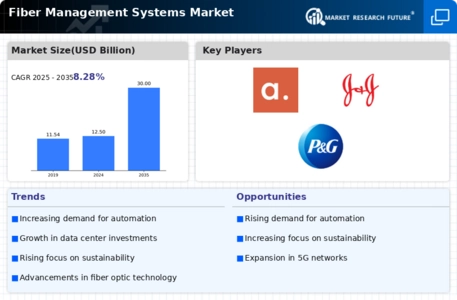Fiber Management Systems Size
Fiber Management Systems Market Growth Projections and Opportunities
The Fiber Management Systems market is influenced by a myriad of factors that collectively shape its dynamics. One significant factor is the ever-growing demand for high-speed internet and data transmission capabilities. As the world becomes increasingly digitalized, there is a surge in the need for efficient fiber optic networks to support seamless communication, data transfer, and internet connectivity. This escalating demand propels the Fiber Management Systems market to develop and innovate in order to meet the evolving requirements of telecommunications and data center infrastructure.
Technological advancements play a pivotal role in shaping the market landscape. With continuous innovations in fiber optic technology, the Fiber Management Systems market witnesses the introduction of more sophisticated and efficient solutions. These technological advancements not only enhance the performance of fiber optic networks but also contribute to the overall growth and competitiveness of the market. As the industry evolves, companies that stay at the forefront of technological innovation are better positioned to capture a larger market share.
Government regulations and initiatives also significantly impact the Fiber Management Systems market. Policies promoting the deployment of fiber optic infrastructure to enhance communication and connectivity contribute to market growth. Government support in the form of subsidies or incentives for the development of robust fiber networks encourages investments in Fiber Management Systems. Additionally, regulatory frameworks that prioritize the expansion of broadband networks contribute to the overall expansion of the market.
Market dynamics are further influenced by the increasing awareness of the environmental impact of traditional cabling systems. Fiber optic networks are considered more environmentally friendly compared to traditional copper-based systems due to their energy efficiency and lower carbon footprint. This growing awareness of environmental sustainability drives organizations and industries to adopt Fiber Management Systems, thereby boosting market growth. As companies focus on green and sustainable practices, the demand for eco-friendly solutions becomes a significant factor in shaping the market.
The competitive landscape and the presence of key market players also play a crucial role in determining the direction of the Fiber Management Systems market. The market is characterized by the presence of both established and emerging players, each striving to gain a competitive edge. Factors such as product innovation, strategic partnerships, and mergers and acquisitions contribute to the competitive dynamics of the market. Companies that successfully differentiate themselves through unique offerings or strategic collaborations are better positioned to thrive in this competitive environment.
Global economic conditions also impact the Fiber Management Systems market. Economic fluctuations, currency exchange rates, and overall market stability can influence the investment decisions of businesses, affecting the demand for Fiber Management Systems. In times of economic growth, there is often an increased investment in infrastructure, including communication networks, driving the demand for Fiber Management Systems. Conversely, economic downturns may lead to a temporary slowdown in market growth.







Leave a Comment